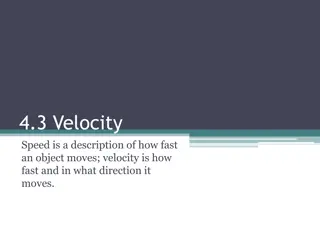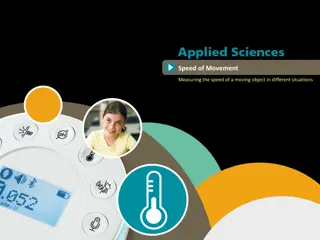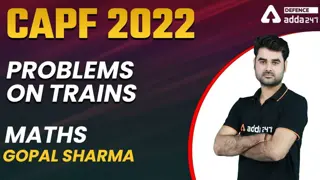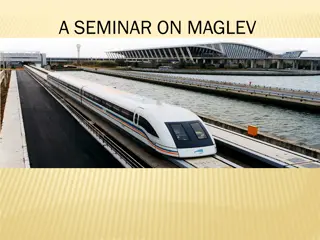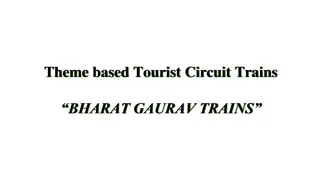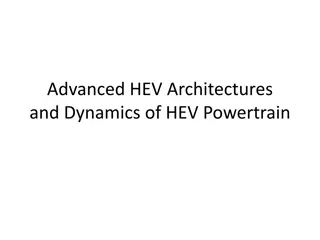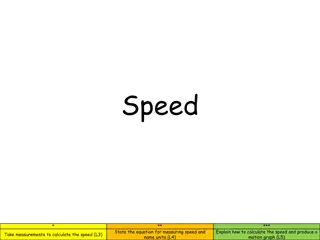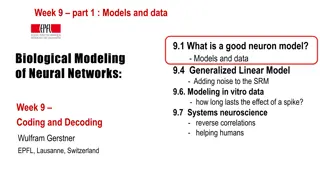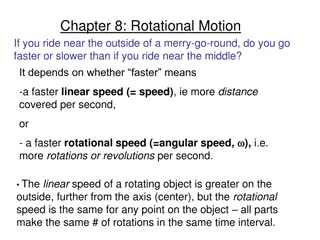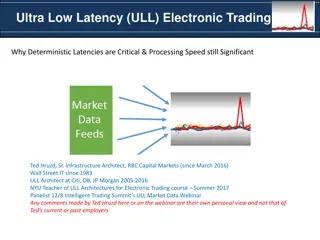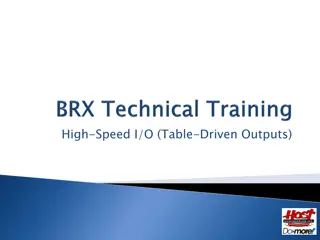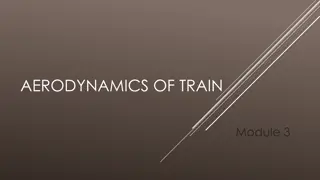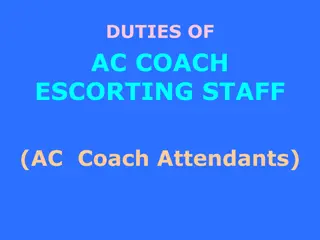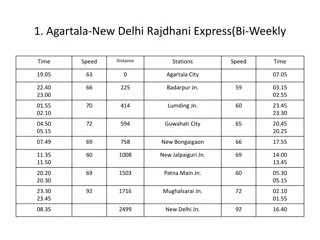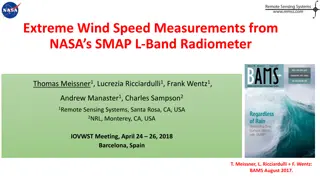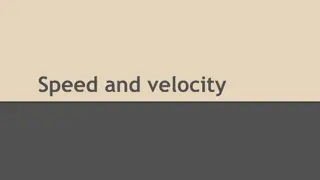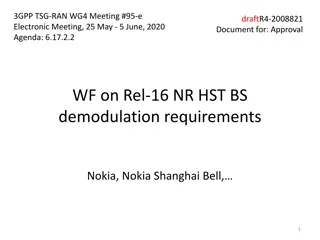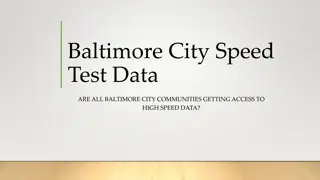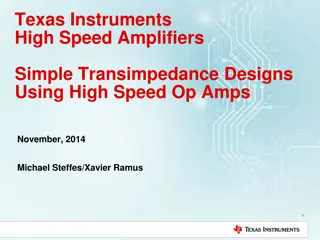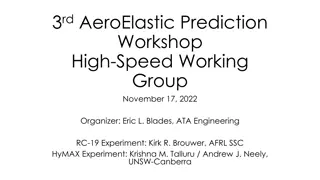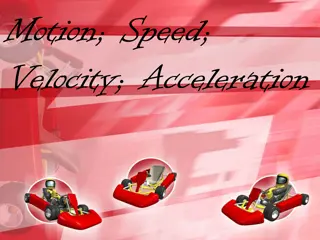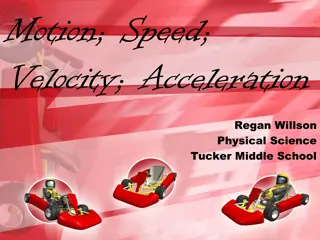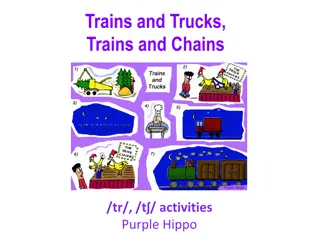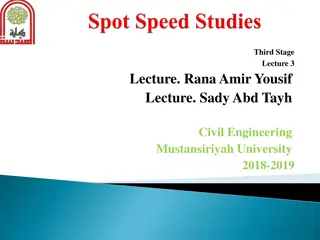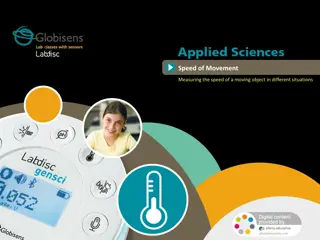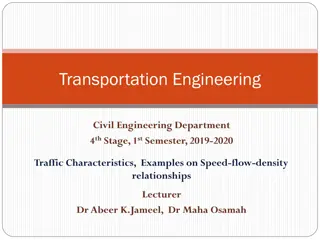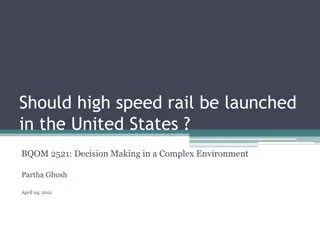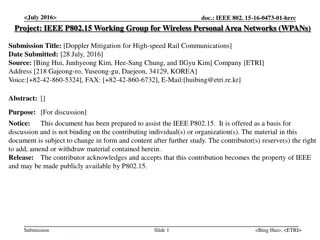Velocity vs. Speed in Physics
Velocity and speed are fundamental concepts in physics that describe how fast an object is moving and in what direction. While speed is a scalar quantity representing the rate of motion, velocity is a vector quantity that includes both speed and direction. Constant velocity implies steady speed and
1 views • 8 slides
Rigid Rotor Balancing and Critical Speed
Explore the concepts of static and dynamic balancing of rigid rotors, determining when a rotor can be assumed rigid based on speed, examining Jeffcott rotor critical speed problems, and discussing the simplest model of rotor systems. Learn about rotor imbalance, free vibrations, natural frequency, a
1 views • 29 slides
Speed of Movement in Different Situations
Exploring the concept of speed in the context of moving objects, this activity aims to analyze changes in speed, create hypotheses, and test them using a built-in GPS sensor. The theoretical background covers the definition of speed, its relation to distance and time, as well as the distinction betw
2 views • 27 slides
Practice Problems on Trains by Gopal Sir
Explore a collection of challenging problems on train timings presented by Gopal Sir. Test your aptitude with scenarios involving trains crossing poles, platforms, tunnels, and more. Improve your problem-solving skills with these intricate questions and solutions.
2 views • 27 slides
Maglev Technology: Levitation, Propulsion, and More
Maglev technology, short for magnetic levitation, utilizes magnetic power to levitate and propel vehicles such as trains. This seminar explores the basic principles, types, and components of Maglev trains, focusing on Electromagnetic Suspension (EMS) and its levitation, propulsion, and lateral guida
0 views • 14 slides
Centrifugation: Industrial and Laboratory Applications
Centrifugation is a procedure that utilizes centrifugal force to separate components based on density in mixtures for both industrial and laboratory purposes. This process involves the rotation of particles at high speeds to induce sedimentation. Different types of centrifuges, such as low-speed and
1 views • 18 slides
Bharat Gaurav Trains: Showcasing India's Rich Heritage & Culture
Bharat Gaurav Trains initiative by Ministry of Railways aims to showcase India's cultural heritage and historical sites through theme-based tourist circuit trains. The policy allows service providers to offer all-inclusive packages to tourists, including rail travel, accommodation, and guided tours.
0 views • 22 slides
Planetary Gear Trains in Hybrid Powertrains
Hybrid powertrains utilize planetary gear trains to achieve different operating modes such as motor-alone, engine-alone, combined mode, and more. These gear trains consist of planetary gears orbiting around a central axis, enabling multiple shaft configurations for input and output. Understanding th
0 views • 55 slides
Speed and Motion: Equations, Calculations, and Graphs
Speed is defined as the distance traveled per unit of time and is measured using the equation Speed = Distance/Time, with units typically in meters per second (m/s). To calculate speed, measure the distance traveled and the time taken. Motion graphs can be used to visualize speed by plotting time on
2 views • 11 slides
Designing a Network-Controlled Railway System with Human Monitoring
Our project aims to design a network-controlled railway system that allows for human intervention and monitoring. The system consists of a main control station, multiple trains, and a communication and power infrastructure. The main control station includes a main microcontroller connecting to a PC,
2 views • 29 slides
Biological Modeling of Neuronal Networks: Insights from Neural Dynamics
Exploring neuron models, generalized linear models, and decoding processes in neural networks through intracellular and extracellular recordings, with a focus on processing models, encoding, and decoding of spike trains. The Spike Response Model and likelihood of spike trains are discussed, providin
0 views • 32 slides
Gear Trains: Kinematics and Dynamics Explained
Gear trains in machines play a vital role in transmitting power between shafts. This chapter prepared by Prof. Divyesh B. Patel covers the basics of gear trains, including types like simple, compound, reverted, and epicyclic. It explains the concept of gear ratios, teeth numbers, and the arrangement
0 views • 11 slides
Gear Trains and Rolling Cylinders in Kinematics of Machines
Gear trains play a crucial role in transferring motion in various machines, while rolling cylinders serve as a fundamental mechanism. This article delves into the applications, variations, and fundamental laws associated with gear trains and rolling cylinders, shedding light on their significance in
1 views • 28 slides
Rotational Motion: Linear vs. Angular Speed
Exploring the concept of rotational motion, this content delves into the comparison between linear speed (tangential speed) and rotational speed (angular speed). It discusses how the linear speed varies based on distance from the axis of rotation, while the rotational speed remains constant for all
0 views • 27 slides
Importance of Ultra-Low Latency in Electronic Trading
Understanding deterministic latencies and processing speed is crucial in ultra-low latency (ULL) electronic trading to ensure optimal access to market data. Ted Hruzd, an industry expert, emphasizes the significance of Speed2 over raw speed (Speed1) in maximizing trading revenue for Market Makers by
2 views • 13 slides
High-Speed I/O Table-Driven Outputs Overview
Explore the capabilities of high-speed I/O table-driven outputs as showcased in the BX10, BX18, and BX36 devices. Learn about the discrete and analog input/output configurations, Ethernet ports, and high-speed features available in these devices. Additionally, understand how to set up and manage out
0 views • 13 slides
Design Speed in Highway Engineering
Design speed in highway engineering refers to the selected speed used to determine the geometric features of roadways. It has evolved over time, with the current definition emphasizing safety, driver expectations, and balancing various factors like social, environmental, and economic considerations.
0 views • 12 slides
The Aerodynamics of Train Systems
The aerodynamic characteristics of high-speed railway trains are unique due to their long length, interaction with surrounding structures, and influence of cross-winds. Aerodynamic drag significantly impacts energy consumption, with the drag being proportional to the square of speed. Precise evaluat
1 views • 11 slides
Duties of AC Coach Escorting Staff: Guidelines for Rail Staff in Air Conditioned Coaches
Guidelines and recommendations for escorting staff in air conditioned coaches and power coaches, including details on the complement of electrical staff needed, duty hours, and staff divisions for Rajdhani trains, deluxe trains, and self-generating coaches. The provided information outlines the requ
0 views • 19 slides
High-Speed Rajdhani Express Train Routes Across India
Explore the routes of various Rajdhani Express trains connecting prominent cities in India such as Agartala, New Delhi, Silchar, Bangalore, Itanagar, and Nizamuddin. Discover the distances covered, travel times, speeds, and stations along the way. Rajdhani Express trains offer a convenient and effic
0 views • 6 slides
Hyderabad Metro Rail Network
The Hyderabad Metro Rail, operated by L&T, spans 67 km across three corridors with 57 stations. With a daily footfall of 4.5 lakh commuters, it offers seamless travel integration with existing railway and bus networks. The trains run from 6:30 AM to 10:30 PM, with frequent services ensuring efficien
1 views • 15 slides
Extreme Wind Speed Measurements from NASA's SMAP L-Band Radiometer
NASA's SMAP (Soil Moisture Active Passive) mission has been collecting data on extreme wind speeds since April 2015 using an L-band radiometer. The measurements provide valuable insights into wind speed frequencies, with a wide range of signals received by the sensor challenging the data analysis. A
3 views • 17 slides
The Stunning Design of Kolkata Metro Trains
Discover the exquisite design details of Kolkata Metro trains through a series of interior and exterior images showcasing branding elements, layout configurations, and more. Immerse yourself in the sleek and modern aesthetics of these public transportation marvels.
0 views • 12 slides
Speed and Velocity in Physics
Speed and velocity are fundamental concepts in physics. Speed is a scalar quantity that can be average or instantaneous, while velocity is a vector quantity that includes direction. Equations such as v=d/t help calculate these values. Average speed and average velocity are important in determining t
1 views • 10 slides
Approval Workflow for Rel-16 NR HST BS Demodulation Requirements
In the TSG-RAN-WG4 Meeting #95-e, various Workflows (WFs) were agreed upon for different scenarios including PUSCH, PRACH, and UL TA. The focus was on defining demodulation requirements for high-speed trains (HST) in the context of 5G NR technology. Manufacturers declared support options for HST sce
0 views • 26 slides
Solving Train Track Problems Using Interval Graphs and Graph Coloring
Presented by Manvitha Nellore, this content addresses real-world train track problems in busy cities by proposing solutions through interval graphs and graph theory. The approach involves allotting tracks to trains by scheduling with time intervals to avoid conflicts. An interval graph is defined, a
3 views • 15 slides
Baltimore City High-Speed Data Access Analysis
The Baltimore City Speed Test Data analysis examines the internet speed access in various communities within Baltimore City. The report includes details on average download speeds, communities with the lowest speeds, and a comparison of internet speed requirements for different online activities. Th
0 views • 7 slides
High-Speed Amplifiers: Design Techniques and Considerations
This detailed document explores the design aspects of high-speed amplifiers, focusing on transimpedance designs using high-speed op-amps. It covers basic and advanced design issues, frequency response analysis, and key considerations for achieving desired performance. The content emphasizes simplifi
0 views • 44 slides
Aeroelastic Prediction Workshop High-Speed Working Group Details
Workshop details for the Aeroelastic Prediction Workshop High-Speed Working Group including information on organizers, experiments, participants, tools used, schedule, registration, and presentation plans. The workshop will focus on sharing results and comparisons related to high-speed aeroelastic p
1 views • 9 slides
Motion, Speed, Velocity, and Acceleration
Motion is when an object changes its place or position. To describe motion accurately, consider the start and end position, movement relative to a reference point, distance traveled, and direction. Speed refers to the distance traveled per unit of time and can be calculated using the formula speed (
0 views • 25 slides
Motion, Speed, Velocity, and Acceleration in Physical Science
Explore the concepts of motion, speed, and velocity along with practical examples and calculations. Learn to describe motion, calculate speed using formulas, solve speed math problems, and understand the different ways to calculate speed. Dive into the world of physical science with explanations and
0 views • 26 slides
Whimsical Tales of Trains, Trucks, Chains, and Cheese
Explore the whimsical world where trains, trucks, chains, and cheese come to life in delightful rhymes. From the magic of trains and trucks bursting through the night to the cautionary tales of cheese-chucking chap, immerse yourself in a collection of fun and light-hearted stories. Discover the uniq
1 views • 9 slides
Spot Speed Studies in Traffic Engineering
Spot speed studies are essential in estimating vehicle speeds in traffic streams, aiding in establishing traffic parameters, control measures, and safety evaluations. These studies involve recording vehicle speeds at specific locations to analyze speed trends, set speed limits, and assess the impact
0 views • 17 slides
Speed and Distance Estimation in Speed Trap Lab
Dive into the world of speed and distance estimation with the Speed Trap Lab. Learn how to calculate speed and distance, taking into consideration uncertainties and variations in time measurements. Explore the relationship between distance, time, and speed through engaging visual aids and practical
0 views • 4 slides
Measuring Movement Speed in Various Situations
Measuring the speed of movement is crucial for various applications. This article explores different methods and factors influencing speed measurement in diverse scenarios, highlighting the importance of accurate speed assessment in scientific research, sports, transportation, and more. Understandin
0 views • 27 slides
Transportation Engineering
In this detailed analysis, we explore traffic characteristics in transportation engineering, focusing on speed-density relationships, flow calculations, and capacity estimations for roadway sections. The example scenarios provide insights into free-flow speed, jam density, speed-flow relationships,
1 views • 19 slides
Solving Problems on Speed, Distance, and Time
Learn how to calculate average speed, total distance, and total time taken in math problems involving speed, distance, and time. Understand the units of speed for different distances and time measurements. Practice solving scenarios to determine speed limits, travel distances, and average speeds of
0 views • 12 slides
Understanding Motion and Speed in Physics
This content covers fundamental topics related to motion and speed in physics, focusing on concepts like frames of reference, distance, displacement, speed, velocity, and calculating speed. It explains how a frame of reference is used to describe motion, the distinction between speed and velocity, a
0 views • 27 slides
High-Speed Rail in the United States: A Complex Decision-Making Process
Explore the historical context, current state, and potential benefits and challenges of launching high-speed rail in the United States. Delve into the BOCR model, strategic criteria, and key considerations for connecting cities with bullet trains. Discover the economic, environmental, technological,
0 views • 16 slides
Doppler Mitigation for High-speed Rail Communications
In this July 2016 submission to IEEE P802.15 Working Group for Wireless Personal Area Networks, Doppler Mitigation for High-speed Rail Communications is discussed. The document explores problems of OFDM-based systems for HSR communications, conventional Doppler compensation methods, and the need for
0 views • 13 slides
